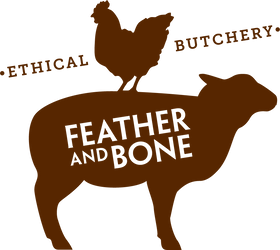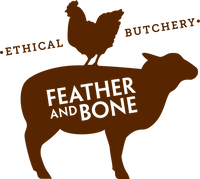Beastly beauty
If you happen to be reading this before your morning coffee and you don't work in a butchery you may find this image and the following fruity outpourings a bit excessive...
This is a detail of a shot taken in our cool room by Laura Courtney, a quasi-vegetarian artist friend, who visited for the first time last week and went weak at the knees when confronted by the beauty of these gorgeous carcasses. That's how we see them too and it's really lovely when others have the same response.
But, because we've seen the farms where these animals lived and know the people who manage them, it's not just the physical beauty of these carcasses that moves us so much. It's also what they represent.
The farms where the animals in our cool room lived are regenerative oases in a scarred farming landscape that has, for the last 200 years, been largely managed with tools and systems designed for younger European ecosystems with plentiful water and fertile, volcanic soils. Australia is isolated, ancient and dry with a unique flora and fauna and it couldn't be more different to the places from which these management practices derive.
Despite the evidence - gaping erosion, dust storms, inexplicable die-back, increasingly severe weather events - generations of farmers have ploughed on with a blind faith in these systems and a spiralling addiction to the chemicals required to ameliorate the damage and maintain viable outputs. Farmers get poorer, land is depleted, species are lost and the only winners are the chemical manufacturers. (If you're skeptical, there's a growing collection of very good books dealing with this issue from a range of perspectives. We'd recommend three to start: A Million Wild Acres, The Biggest Estate on Earth and The Call of the Reed Warbler.)
But the farmers with whom we're fortunate enough to work have chosen a different direction altogether. Many of them have had Eureka moments, causing them to screech to a halt on the conventional road and veer sharply off track in pursuit of a much more nuanced, intelligent and responsive approach. All of them are clever, patient, fastidious, passionate and determined and their idea of long term is decades and centuries. They not only feed us but take it upon themselves to repair, improve and revitalise the land to ensure continued fertility and productivity. The rest of us owe them a debt for the work they do on our collective behalf.
So when we marvel at the beauty of the strong, healthy carcasses hanging in our cool room, we're also marvelling at the work that went into producing them and paying our humble respects to the lives given up to feed us, now and into the future.
That is actually a perfect segue into our Autumn Butchery Classes, all of which start in the cool room admiring and discussing these carcasses.
This is a detail of a shot taken in our cool room by Laura Courtney, a quasi-vegetarian artist friend, who visited for the first time last week and went weak at the knees when confronted by the beauty of these gorgeous carcasses. That's how we see them too and it's really lovely when others have the same response.
But, because we've seen the farms where these animals lived and know the people who manage them, it's not just the physical beauty of these carcasses that moves us so much. It's also what they represent.
The farms where the animals in our cool room lived are regenerative oases in a scarred farming landscape that has, for the last 200 years, been largely managed with tools and systems designed for younger European ecosystems with plentiful water and fertile, volcanic soils. Australia is isolated, ancient and dry with a unique flora and fauna and it couldn't be more different to the places from which these management practices derive.
Despite the evidence - gaping erosion, dust storms, inexplicable die-back, increasingly severe weather events - generations of farmers have ploughed on with a blind faith in these systems and a spiralling addiction to the chemicals required to ameliorate the damage and maintain viable outputs. Farmers get poorer, land is depleted, species are lost and the only winners are the chemical manufacturers. (If you're skeptical, there's a growing collection of very good books dealing with this issue from a range of perspectives. We'd recommend three to start: A Million Wild Acres, The Biggest Estate on Earth and The Call of the Reed Warbler.)
But the farmers with whom we're fortunate enough to work have chosen a different direction altogether. Many of them have had Eureka moments, causing them to screech to a halt on the conventional road and veer sharply off track in pursuit of a much more nuanced, intelligent and responsive approach. All of them are clever, patient, fastidious, passionate and determined and their idea of long term is decades and centuries. They not only feed us but take it upon themselves to repair, improve and revitalise the land to ensure continued fertility and productivity. The rest of us owe them a debt for the work they do on our collective behalf.
So when we marvel at the beauty of the strong, healthy carcasses hanging in our cool room, we're also marvelling at the work that went into producing them and paying our humble respects to the lives given up to feed us, now and into the future.
That is actually a perfect segue into our Autumn Butchery Classes, all of which start in the cool room admiring and discussing these carcasses.





Leave a comment